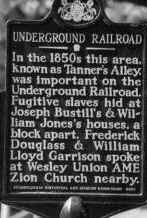
Study Areas:
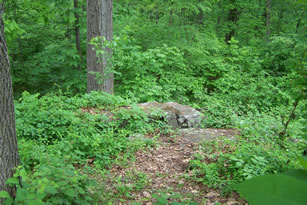
Beta Delta "Black Ducks" UGRR Hideout
"Dowse-the-Glim Cave," Culp's Hill, Gettysburg
article by George F. Nagle, with thanks to Craig Caba1
The Beta Deltas were a group of thirty-three Pennsylvania College students, members of the classes of 1858 through 1862, who formed an unofficial and unsanctioned fraternity at the college. In a reminiscense published in 1902, fraternity member J. Howard Wert recalled that the organization was "a source of unmitigated annoyance" to town and college officials due to their "wild...and law defying" behavior.2
Known by outsiders as the B.D.s, and internally as the Black Ducks, members kept an apartment, dubbed by them "the slum," on the second story of a frame building on East Middle Street in Gettysburg, directly across the street from the Methodist Church. They also maintained additional rendezvous spots around town and in the surrounding countryside that generally were known only to the group leaders.3
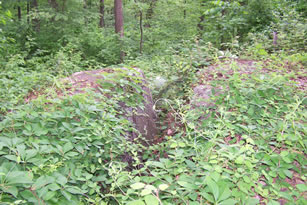 One of these secret spots was located well outside of town on the summit of Culp's Hill. It was a natural cleft between two very large boulders, which five members of the fraternity labored to convert into a "cave." Wert described it in a 1904 article:
One of these secret spots was located well outside of town on the summit of Culp's Hill. It was a natural cleft between two very large boulders, which five members of the fraternity labored to convert into a "cave." Wert described it in a 1904 article:
"It's a mile over there, right on the crest of Culp's Hill. There were two rocks parallel with each other, about five feet apart, that rose to the height of ten feet. The sides were as regular as if adjusted with a plumb line. We walled up one end. At the other, the rapid rise of the hill brings the ground up to a level with the top of the rocks. We made a roof over the same space between the rocks with a heavy corn wood. All artificial work was heavily banked and covered with earth, and this again the leaves in great masses. There is one carefully concealed entrance at the point where the upward swell of the hill gives a steep descent into the rayless dungeon." 4
This manmade cave was christened "Dowse-the-Glim Cave" by the Ducks,5 and its creation was solely intended to give privileged fraternity members shelter from the outside world. It would soon play a more humanitarion role, however.
 In December 1859, around Christmas time, some of the Black Ducks were celebrating the holidays in the "Slum" when a member brought news of a fugitive slave that he had found wandering, frightened, through the snow-covered streets of Gettysburg. The freedom seeker had been hiding in one of the "shanties on the lane [in] back of Washington Street," when a slave catcher, accompanied by a U.S. Marshal had begun searching the neighborhood, thus forcing the fugitive back into flight. The college boy found him, cold and hungry, and had brought him to the East Middle Street apartment.6
In December 1859, around Christmas time, some of the Black Ducks were celebrating the holidays in the "Slum" when a member brought news of a fugitive slave that he had found wandering, frightened, through the snow-covered streets of Gettysburg. The freedom seeker had been hiding in one of the "shanties on the lane [in] back of Washington Street," when a slave catcher, accompanied by a U.S. Marshal had begun searching the neighborhood, thus forcing the fugitive back into flight. The college boy found him, cold and hungry, and had brought him to the East Middle Street apartment.6
After some spirtited discussion as to what course of action to take, it was decided to take the fugitive to the Culp's Hill location, which was unkown to all but a half-dozen of the Black Ducks. There, securely hidden and insulated by the earth and leaves, the fugitive stayed for two days, until the Ducks made contact with some Quaker activists in nearby York Springs.7 Wert presumed that the Quakers, most likely William and Phoebe Wright, then sent the fugitive on to Harrisburg.
The two-day delay in forwarding the slave may have been caused by the unfamiliarity of the Black Ducks with the local Underground Railroad network. Wert himself stated that "the majority of them would have scorned the appellation of abolitionist, and rejected with scorn the idea of becoming agents of the Underground Railroad."8 Although their attitudes reflected the regional distate with abolitionism, their encounter with an actual freedom seeker, with whom they shared food and drink before hiding him, opened their eyes to an issue that could no longer be ignored.
Over the next two months, as word of their actions filtered into the Gettysburg African American community, they became increasingly involved in hiding runaways. One of their chief contacts appears to have been John "Jack" Hopkins, an African American custodian at the college. Hopkins was believed to intercept runaways traveling along the unfinished railroad line that ran from Thaddeus Stevens' Caledonia Iron Works, and terminated near the college buildings. As an employee of the college, Hopkins could easily contact one of the Black Ducks, who would then make arrangements to secretly transport a recently-arrived fugitive out to Dowse-the-Glim Cave on Culp's Hill until a safe journey to York Springs could be made.9
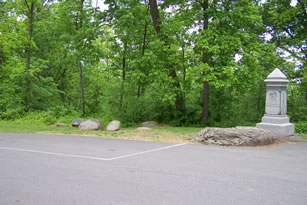 Dowse-the-Glim Cave can still be easily viewed today,10 although few people know its location. Ironically, it lies within a few yards of one of the most famous and heavily-visited Civil War battlefield sites: the summit of Culp's Hill. The artificial roof and end wall of the hideout were destroyed by the Union troops that occupied the slopes of Culp's Hill during the battle, and the distinctive space between the rocks has been largely filled in over the years. It remains, however, as a testament to the efforts of a select group of college students to defy the law and the prevailing social attitudes of thier community, and do right for some of their fellow men.
Dowse-the-Glim Cave can still be easily viewed today,10 although few people know its location. Ironically, it lies within a few yards of one of the most famous and heavily-visited Civil War battlefield sites: the summit of Culp's Hill. The artificial roof and end wall of the hideout were destroyed by the Union troops that occupied the slopes of Culp's Hill during the battle, and the distinctive space between the rocks has been largely filled in over the years. It remains, however, as a testament to the efforts of a select group of college students to defy the law and the prevailing social attitudes of thier community, and do right for some of their fellow men.
Notes
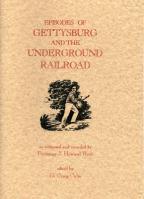 1. Greatful thanks to Craig Caba for taking me to the site of the Black Ducks' cave on Culp's Hill, as well as for a guided tour of Underground Railroad sites in Gettysburg and Adams County. Craig is the curator and caretaker of the Wert Gettysburg Collection, and has extensive knowledge of the operations of the Underground Railroad in this area. He is the author of several books on the subject, including Episodes of Gettysburg and the Underground Railroad, published in 1998, and Gettysburg: 1836 Battle Over Slavery, published in 2004. Both books are available from Craig Caba at 2520 Lamb's Gap Road, Enola, PA 17025. Much of the cited material in this article is from Episodes, pages 67-80.
1. Greatful thanks to Craig Caba for taking me to the site of the Black Ducks' cave on Culp's Hill, as well as for a guided tour of Underground Railroad sites in Gettysburg and Adams County. Craig is the curator and caretaker of the Wert Gettysburg Collection, and has extensive knowledge of the operations of the Underground Railroad in this area. He is the author of several books on the subject, including Episodes of Gettysburg and the Underground Railroad, published in 1998, and Gettysburg: 1836 Battle Over Slavery, published in 2004. Both books are available from Craig Caba at 2520 Lamb's Gap Road, Enola, PA 17025. Much of the cited material in this article is from Episodes, pages 67-80.
2. Caba identifies all thirty-three members of the Black Ducks in Episodes. The Wert quote is from page 73.
3. The "modest frame building" on East Middle Street in Gettysburg that housed the second floor "slum" of the Black Ducks is still standing directly across from the GAR post building.
4. Caba, Episodes, p. 75-76.
5. "Dowse-the-glim," or "douse-the-glim," is an old phrase meaning to hastily put out or extinguish a lamp or candle. It is an apt name for a cave on a remote hilltop, as lights from a candle or lamp would be easily spotted from town, and the location revealed.
6. Washington Street, and the alleys behind it, was the site of much of Gettysburg's African American community. It is logical that slave catchers, knowing that the local Black community had been for years actively involved with aiding and hiding fugitives, would start searches there.
7. Originally York Sulphur Springs, and also known as Petersburg. See Caba, Episodes, p. 92-97.
8. Caba, Episodes, p. 73.
9. Ibid. 76. John "Jack" Hopkins is identified by J. Howard Wert in later writings as the chief contact between the Black Ducks and Gettysburg's African American community. His involvement with aiding freedom seekers pre-dated working with the Black Ducks. Hopkins was known to and worked with abolitionist Thaddeus Stevens in guiding, sheltering and aiding fugitive slaves passing through Gettysburg.
10. Easily is, perhaps, a relative term. As can be seen in the photographs, the site is overgrown with goose grass, thorny wild blackberry bushes, and poison ivy. It can be difficult to spot even for a person who knows the location. The best viewing time is winter, when the undergrowth of natural vegetation has died back. The space between the rocks is no longer an impressive five feet wide and ten feet high, having accumulated 160 years of debris and dirt.
11. All photographs on this page copyright © 2010 George F. Nagle and Afrolumens Project.
Now Available on this site
The Year of Jubilee
Vol. 1: Men of God and Vol. 2: Men of Muscle
by George F. Nagle
Both volumes of the Afrolumens book are now available on this website. Click the link to read.
The Year of Jubilee is the story of Harrisburg'g free African American community, from the era of colonialism and slavery to hard-won freedom.
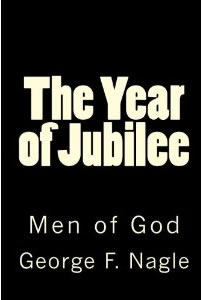 Volume One, Men of God, covers the turbulent beginnings of this community, from Hercules and the first enslaved people, the growth of slavery in central Pennsylvania, the Harrisburg area slave plantations, early runaway slaves, to the birth of a free black community. Men of God is a detailed history of Harrisburg's first black entrepreneurs, the early black churches, the first black neighborhoods, and the maturing of the social institutions that supported this vibrant community.
Volume One, Men of God, covers the turbulent beginnings of this community, from Hercules and the first enslaved people, the growth of slavery in central Pennsylvania, the Harrisburg area slave plantations, early runaway slaves, to the birth of a free black community. Men of God is a detailed history of Harrisburg's first black entrepreneurs, the early black churches, the first black neighborhoods, and the maturing of the social institutions that supported this vibrant community.
It includes an extensive examination of state and federal laws governing slave ownership and the recovery of runaway slaves, the growth of the colonization movement, anti-colonization efforts, anti-slavery, abolitionism and radical abolitionism. It concludes with the complex relationship between Harrisburg's black and white abolitionists, and details the efforts and activities of each group as they worked separately at first, then learned to cooperate in fighting against slavery. Read it here.
Non-fiction, history. 607 pages, softcover.
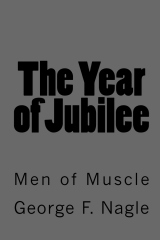 Volume Two, Men of Muscle takes the story from 1850 and the Fugitive Slave Law of 1850, through the explosive 1850s to the coming of Civil War to central Pennsylvania. In this volume, Harrisburg's African American community weathers kidnappings, raids, riots, plots, murders, intimidation, and the coming of war. Caught between hostile Union soldiers and deadly Confederate soldiers, they ultimately had to choose between fleeing or fighting. This is the story of that choice.
Volume Two, Men of Muscle takes the story from 1850 and the Fugitive Slave Law of 1850, through the explosive 1850s to the coming of Civil War to central Pennsylvania. In this volume, Harrisburg's African American community weathers kidnappings, raids, riots, plots, murders, intimidation, and the coming of war. Caught between hostile Union soldiers and deadly Confederate soldiers, they ultimately had to choose between fleeing or fighting. This is the story of that choice.
Non-fiction, history. 630 pages, softcover.

